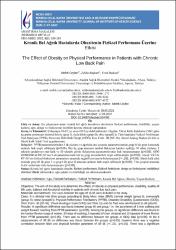Kronik Bel Ağrılı Hastalarda Obezitenin Fiziksel Performans Üzerine Etkisi
Özet
Giriş ve Amaç: Bu çalışmanın amacı kronik bel ağrılı hastalarda obezitenin fiziksel performans, özürlülük, yaşam
kalitesi, ağrı, denge ve fonksiyonel mobilite üzerine etkisini saptamaktır.
Gereç ve Yöntemler: Çalışmaya 18-65 yaş arası 102 kişi dahil edilmiştir. Olgular; Vücut Kütle İndeksine (VKİ) göre
üç gruba ayrılmıştır (normal kilolu (grup I), fazla kilolu (grup II), obez (grupIII)). Tüm hastalara Fiziksel Performans
Test Bataryası (FPTB), Oswestry Özürlülük Ölçeği (OÖÖ), Kısa Form- 36 (KF-36), Görsel Analog Skalası (GAS) ve
Süreli Kalk Yürü Testi uygulanmıştır.
Bulgular: FPTB parametrelerinden 5 dk yürüme ve ağırlıkla öne uzanma parametrelerinde grup III ile grup I arasında
anlamlı fark tespit edilmiştir (p<0.05). Her üç grup arasında lumbal fleksiyon hareket açıklığı, 50 adım yürüme, 5
tekrarlı sandalyeye otur kalk ve 10 tekrarlı gövde fleksiyonu parametrelerinde fark bulunmamıştır (p>0.05). OÖÖ
verilerinde ve KF-36’nın 8 alt parametresinde her üç grup arasında fark tespit edilmemiştir (p>0.05). Ancak VKİ ile
KF-36’nın fiziksel fonksiyon parametresi arasında negatif korelasyon bulunmuştur (r=-,231; p<0.05). Süreli kalk yürü
testinde grup III ile grup I ve grup I ile grup II arasında anlamlı fark tespit edilmiştir (p<0.05). Tüm gruplar arasında
GAS verilerinde fark bulunmamıştır (p>0.05).
Sonuç: Kronik bel ağrılı hastalarda obezite; fiziksel performans, fiziksel fonksiyon, denge ve fonksiyonel mobiliteyi
olumsuz olarak etkilemekte, ağrı şiddeti ve özürlülüğü ise etkilememektedir. Objective: The aim of this study is to determine the effects of obesity on physical performance, disability, quality of
life, pain, balance and functional mobility in patients with chronic low back pain.
Materials and Methods: 102 cases between the ages of 18-65 were included in the study.
Cases; It is divided into three groups according to Body Mass Index (BMI) (normal weight (group I), overweight
(group II), obese (groupIII)). Physical Performance Test Battery (PPTB), Oswestry Disability Questionnaire (ODQ),
Short Form- 36 (SF-36), Visual Analogue Scale (VAS) and Time Up and Go Test were administered to all patients.
Results: A significant difference was found between group III and group I in the parameters of 5 min walking and
weight forward reaching from PPTB parameters (p<0.05). Among the groups, no significant difference was found in
the lumbar flexion range of motion, 50 steps of walking, 5 repeated of chair sit-stand and 10 repeated of trunk flexion
from PPTB parameters (p>0.05). There was no difference between the groups in ODQ data (p>0.05). In the 8
subparameters of SF-36 no difference was found between the groups (p>0.05), however there was a negative
correlation between BMI and physical function parameter of SF-36 (r=-,231; p<0.05). There was a significant
187
difference between group III and group I and between group I and group II in timed up and go test (p<0.05). There
was no difference in VAS data between the groups (p>0.05).
Conclusion: Obesity in patients with chronic low back pain negatively affects physical performance, physical
function, balance and functional mobility, but does not affect the pain severity and disability.
















